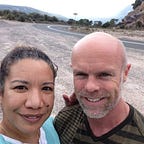The Spirituality of Totality
“Looking God in the eye” binds your nervous system to the Universe, by Bill Softky
We have all known spiritual wonder under a starry night sky, feeling miniscule as black infinity stretches away in all directions, staring straight into the center of the Universe. What if the Universe stared back?
It felt like that a little after ten on Monday morning in John Day, Oregon. For the first time in my life I looked right at the Sun, and saw the black disc image of Totality. The experience was not only sublimely beautiful, but still days later feels life-transforming. It was the most beautiful natural experience of my life, yet somehow deeply intimate. I’ll list below some scientific reasons why.
The key is full-spectrum sensory experience, continous in time and space. In the quickly fading morning light, my wife and I clambered up an embankment at the mountaintop airport, looking for a vantage point from which to view not just the eclipse but the horizon. Nearby, a photographer had set up tripods with time-lapse cameras. He introduced himself, Don Davis, and told us stories of eclipses all around the world, and cool optical effects to look for. “But why,” I asked, “have you spent so much time and money just to see eclipses?”
“Have you seen one yourself?” he asked me back, a twinkle in his eye. “Well, no,” I admitted. His smile broadened. “Just wait, you’ll see.”
I saw.
Within a minute I was crying from the beauty. Here are my guesses why:
The black disc and corona look like a human pupil and iris at eye-gazing distance. If the similarity isn’t obvious to you, at least consider the dimensions. The black disc subtends about a half a degree of angle, as does a human pupil a foot and a half away (half a meter). Both look like sharp black circles radiating filaments. The similarity doesn’t need to actually fool your conscious mind to still evoke subconscious neural hints of interpersonal intimacy and connection. It really does feel like looking the Universe in the eye.
The image of Totality is physically impossible. The moon and the planets look like spheres, illuminated from the side; even fireworks look like physical things. But Totality doesn’t look like any possible physical object, perhaps because it isn’t an object. It is instead a special kind of optical illusion, only visible from a specific vantage point.
You are at the axial center of the Universe. Normally, light sources in the night sky look like ordinary stars (point sources) or planets (illuminated spheres), pretty much the same from any direction in 3-D space, which means that looking at them doesn’t tell you where you are. But the image of Totality is flat. We already know that whenever you see a perfect circle in a 3-D world, you must be seeing it dead-on, right along its central axis. So when you see the sun as a flat disc, your nervous system knows you’re on the central axis of this Universe, right here, right now. (The similarity gets even more specific: of all possible radial profiles of muscular sensation in a spine, one of the best looks just like our image: an empty center surrounded by a ring which then fades out…so Totality looks like your core).
You are at the axial center of the Earth. Yes, our minds all “know” the Earth is round, but to our nervous systems the Earth feels flat beneath our feet. During Totality, the entire horizon becomes an orange 360-degree ring of twilight, surrounding a dark center. The surface of the Earth still feels flat, but the illumination is no longer uniform. Now the flatness has a center, where you stand.
Continuity in space and time creates experiential unity. During an eclipse, normal sunlight slowly dims to night, then brightens back. There are no distcontinuities, no sudden flashes, clicks, or explosions. So whatever happens remains tethered into normal life, not separated in time. Likewise, you see the image of Totality where the sun has always been, part of the same continuous space connecting the stars with the horizon and the Earth. Continuous experience weaves a fleetingly impossible, intimate image inextricably into normal life.
Human resonance amplifies and validates the spiritual experience. When people gather with a common intention, the intention amplifies, and the more focused the intention and the more powerful the experience, the stronger the common resonance and resulting sense of spiritual community. Pilgrims, cathedral-goers, and mountain-climbers know this. I think Totality is spiritual in groups, the central sacrament of a truly Natural religion consistent with the usual ones. After all, didn’t God make the Sun and Moon?
In the astronomical scheme of things, such eclipses are freakishly unusual. Most planets don’t have moons. Most moons are too small to cover the sun at all, or too big to provide the eye-like image, the briefness, the rarity of ours. By its very optical structure, Totality seems tuned to pluck our nervous systems’ deepest chords.
I know I’ll want to experience Totality again in 2024. I hope that the commercial infrastructure works better then, and that I find a lot of friends to do it with.
(For tips on making your next experience the best one possible, look here: https://medium.com/@realvsdigital/an-ideal-totality-experience-c58b91e8e06e)
